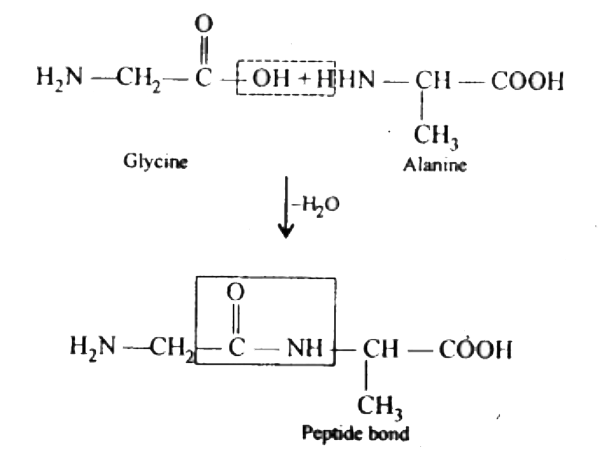Defines the following as related to proteins:
(i)Peptide linkage,(ii)Primary structure
(iii)Denaturation
(i) Peptide bond : Proteins are condensation polymers of α−amino acids in which the same or different α−amino acids are joined by peptide bonds. Chemically, a peptide bond is an amide linkage formed between −COOH group of one α−amino acid and −NH− group of the other α-amino acid by loss of a molecule of water. For example,

(ii) Primary structure: Proteins may contain one or more polypeptide chains. Each. polypeptide chain has a large number of α−amino acids which are linked to one another in a specific manner. The specific sequence in which the various amino acids present in a protein linked to one another is called its primary structrue. Any change in the sequence of α−amino acids creates a different protein.
(iii) Denaturation : Each protein in the biological system has a unique three dimensional structure and has specific biologicalactivity. This is called native form of a protein. When a protein in its native form is subjected to a physical change such as change in temperature or a chemical change like change in pH, etc, hydrogen bonds gets broken. As a result, soluble forms of protenis undergo coagulation or precipitation to give fibrous proteins which are insoluble in water. this coagulation also results in loss of biological activity of the proteins and this loss in biological acitivity, is called denaturation. During denaturation, 2∘ and 3∘ structures of proteins are destroyed but 1∘ structure remains intact.
The most common example of denaturation of proteins is the coagulation of albumin present in the white of an egg. When the egg is boiled hard the soluble globular protein present in it is denatured and is converted into insoluble fibrous protein.

Topper's Solved these Questions
Similar Questions
Define the following as related to proteins:
(i)Peptide linkage (ii)Primary structure
(iii)DenaturationView SolutionDefine the following as related to proteins :
(i) Peptide linkage
(ii) Primary structure
(iii) DenaturationView SolutionDefine the following as related to proteins:
(i) Peptide linkage (i) Primary structure (iii) Denaturation.View SolutionDefine the following as related to proteins :
(i) Peptide linkage
(ii) Primary structure
(iii) DenaturationView SolutionDefine the following terms as related to proteins :
(i) Peptide linkage (ii) Primary structure .
(iii) Denaturation.View SolutionDefine the following terms in relation to proteins :
Peptide linkageView SolutionDefine the following as related to proteins.
(i) peptide linkage
(ii) Denaturation.View SolutionDefine the following terms in relation to proteins :
(i) Peptide linkage . (ii) Denaturation.View SolutionDefine a 'Peptide linkage'.
View SolutionDefine the following terms in relation to proteins :
DenaturationView Solution

